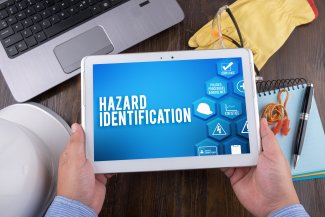Hazard Identification

Price
Purchase
Overview
Risk consists of four elements,
- A hazard;
- The consequences of that hazard (safety, environmental and economic);
- The likelihood of occurrence of that hazard; and
- Safeguards that reduce consequences or likelihood.
The relationship between the first of the above three terms is shown in Equation (1).
RiskHazard = Consequence * Predicted Frequency . . . . . (1)
The first and most important step in any risk management program is to identify the hazards. Hazard analysis is the most important step in risk analysis because, unless hazards are identified, consequence and likelihood reduction cannot be implemented. In the context of process safety and operational integrity programs this usually means that a Process Hazards Analysis (PHA) must be conducted.
Not only is hazard identification the most important part of any risk analysis, removal of hazards is almost always the best way of reducing risk, and it is the only way in which risk can be reduced to zero. Reductions in the consequence and frequency terms — the second and third elements of Equation (1) — can only reduce risk; they cannot eliminate risk entirely.
Companies in the process industries habitually handle large quantities of toxic, flammable and explosive materials — often at high temperature and pressure. Such processes are inherently hazardous, and have the potential to cause loss-of life, serious injuries and severe pollution. Since these processes are often quite complex and sophisticated and have many recycle streams, it means that the identification of hazards is not an easy process. Therefore a wide range of PHA techniques has been developed and used over the years. The key to almost all of these techniques is that a team of experts analyzes the process in question to determine how major failures — often involving a very unlikely sequence of events — could occur.
A PHA is not concerned with occupational hazards such as trips, falls, and the use of lock-out/tag-out rules. Instead it focuses on process-related issues such as over-pressuring a vessel or damage caused by corrosion.
Effective hazards analyses go beyond the mere identification of hazards, however — they help create a frame of mind in which everyone is looking for hazards all the time, and then taking corrective action. For example, an operator working by himself at two o’clock in the morning may be about to open a valve, but before doing so he pauses for a moment, and says to himself:
"You know, opening this valve could lead to reverse flow, which could lead to wrong chemicals mixing with each other, and . . . you know what — before opening the valve, maybe I should take a break, make a cup of tea, and talk over what I’m planning to do with my colleagues and supervisor."
When an employee thinks and acts in this manner, the hazards analysis program is working very well indeed because it has become a part of the broader topics of culture and workforce involvement.
Table of Contents
Introduction
Hazards Management Process
Step 1. Identify the Hazards
Creative / Imaginative Techniques
Experience-Based
Logical / Rational
Step 2. Risk Rank
Step 3. Eliminate or Substitute the Hazard
Step 4. Remove the People
Step 5. Reduce the Consequence
Step 6. Reduce the Likelihood
Step 7. Install Safeguards
Organization of a Hazards Analysis
Charge / Scope Letter
Objective
Physical Scope
Method(s) to be Used
Assigned Personnel
Risk Management Guidance
Schedule and Reporting
Abandoned Equipment
Preparations
Logistics
Meeting Protocol
Location of the Meeting
Projection of Notes
Documentation Requirements
Security of the Information
Time Required
Kick-Off and Close-Out Meetings
HAZID / Major Hazards Screening
The Team
Leader / Facilitator
Process Knowledge
Stimulate Thinking
Creative Thinking
Casual Remarks
“If we had unlimited money”
Generalizations
Team Management
Knowledge of Actual Incidents
Lawyer-Like Behavior
Persona
Personal Preparation
Engineering Standards
The Scribe
Operations / Maintenance Expert
Process and Instrument Experts
Specialists
Use of Sophisticated Language
The One-Minute Engineering Department
Results of the Analysis
Findings
Recommendations
Action Items
Risk Register
Finding Number and Date
Hazard
Source
Consequence(s) / Likelihood / Risk
Follow-Up
The Hazards Analysis Report
Completeness of the Notes
Cross-Reference
Anonymity
Findings Terminology
Completeness
‘Non-Findings’
Appearance
Pictures
Report Distribution
Communication with the Public
Table of Contents
1. Disclaimer
2. Executive Summary
3. Objectives of the Analysis
4. Summary of Findings
5. Method Used
6. Risk Ranking
7. The Team
8. Regulations and Standards
9. Attachments
10. Meeting Notes
Development of the Report
Step 1. Notes Clean-Up
Step 2. Team Review
Step 3. Draft Report
Step 4. Client Review
Step 5. Final Report
Step 6. Risk Register
Legal Issues
Need to Act on Findings
Informal Notes
Internal Communication
PHA Leadership
Special Types of Hazards Analysis
Temporary and Transient Operations
Non-Process Applications
Decommissioning / Demolition
Overlooked Hazards
Revalidation Hazards Analyses
Benefits and Limitations of Hazard Analyses
Strengths
Providing Time to Think
Challenging Conventional Thinking
Cross-Discipline Communication
Education
Development of Technical Information
Economic Payoff
Limitations and Concerns
Imprecision in Defining Terms
Multiple Contingencies
Complexities and Subtle Interactions
Dynamic Conditions
Knowledge of Safe Operating Limits
Lack of Quantification
Team Quality
Personal Experience
Boredom
TRIZ
Confusion with Design Reviews
False Confidence
Equipment Orientation
Interfaces
Human Error
The Hazard and Operability Method (HAZOP)
Step 1. Node Selection and Purpose
Selection of Nodes
Pressure/Spec Breaks
Step 2. Process Guideword / Safe Limits
Step 3. Identification of Hazards and their Causes
Step 4. ‘Announcement’ of the Hazard
Step 5. Consequences
Step 6. Identification of Safeguards
Step 7. Predicted Frequency of Occurrence of the Hazard
Step 8. Risk Rank
Step 9. Findings
Step 10. Next Process Guideword / Node
Effectiveness of HAZOPs
Checklists
Checklist Categories and Guidewords
Structure of a Checklist
The What-If Method
Node / Functional Area Review
Equipment and Function Review
Ignition Source Controls
Instrumentation and Control Systems
Human Factors
Process Upsets
Siting
Structured What-If
Utility Systems
Batch Processes
Operating Procedures
Layout Reviews
What-If / Checklist Method
Failure Modes & Effects Analysis
Bow Tie Analysis
Indexing Methods
Interface Hazards Analysis
Software
Copyright © Ian Sutton. 2018. All Rights Reserved.
